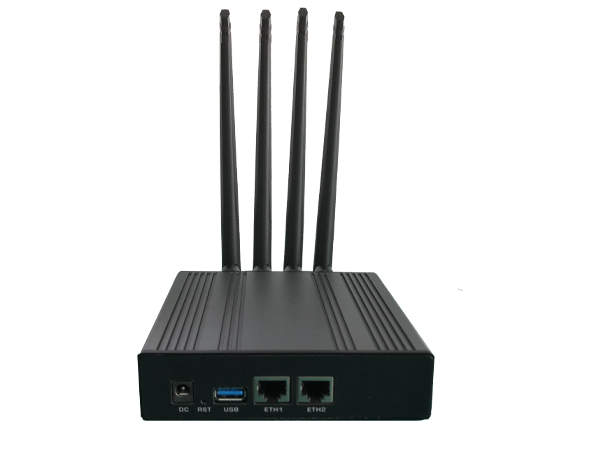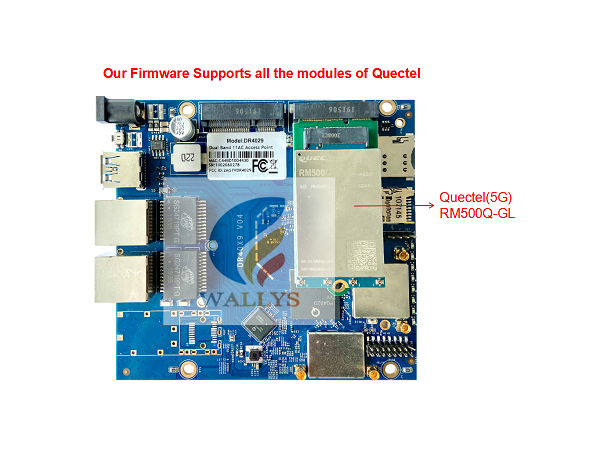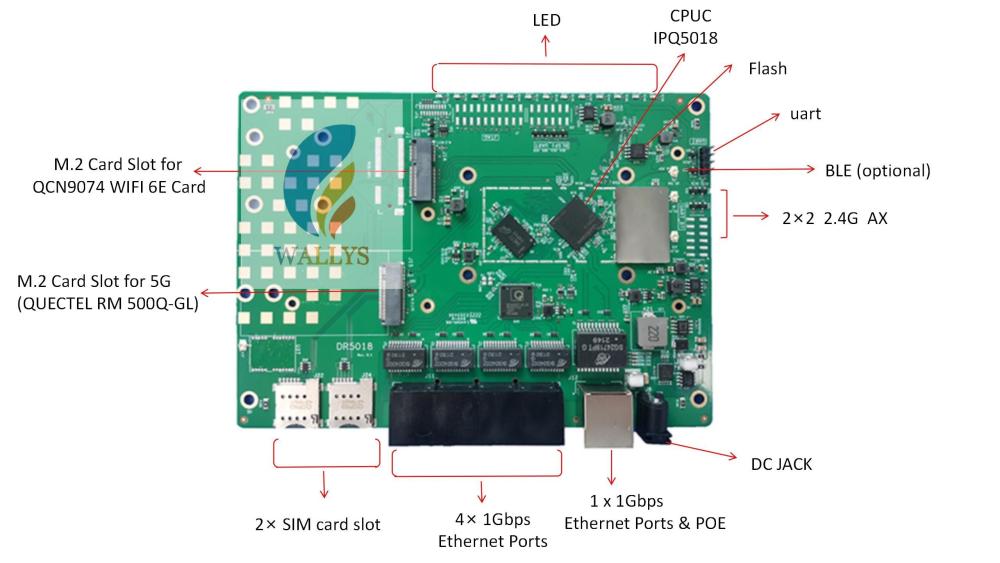-
Posts
3 -
Joined
-
Last visited
Recent Profile Visitors
The recent visitors block is disabled and is not being shown to other users.
Cindy Zhu's Achievements
-
DR-AP40X9-A https://www.wallystech.com/Industrial_Wireless_AP/DR-AP40X9-A-Qualcomm-IPQ-4019-IPQ-4029-5G-4G-LTE-aluminum-body-dual-band-wifi-router-2.4GHZ-5GHz-QSDK-firmware.html BY:Wallys Communications (Suzhou ) Co., LTD EMAIL:[email protected] We mainly develop high power wireless products based on Quacomm chip such asIPQ6000/IPQ6018/IPQ6010/IPQ4019/IPQ4029/IPQ8072/IPQ8074/QCN9074 and so on . Description DR-AP40X9-A is a 2x2 2.4G&5G high power Radio AP Router which including 1x DR40X9(IPQ4019/IPQ4029) Board;2 x 2.4G&5G dipole Antennas; 1 x PSU(DC power or PoE); 1 x Enclosure. Dipole antenna ■ 2 x 2.4G&5G Antenna ■ 5dBi 2.4GHz/5Ghz ■ SMA Plug interface ■ Plastic rod of black ■ RoHS compliance Enclosure ■ Dimension: 132x 119 x 34 mm ■ Aluminum alloy material ■ Support WallysDR40X9 The IPQ4019/4029 Board is capable of providing up to 10.5 kilometers of wireless transmission range on the 2.4 GHz frequency and up to 20 kilometers on 5 GHz. The integrated antenna features an omni-directional design, creating a more reliable communications link between your devices no matter where they are located in the room. The dipole antenna configuration delivers better performance at shorter distances especially when you have multiple APs located close together in the same building or in different buildings. For more products please visit: https://www.wallystech.com/product.html Follow us in the Youtube: https://www.youtube.com/channel/UClmu7LBz_OWxe2VckkQr3tw Email: [email protected]
-
IPQ4019 and IPQ4029 are both system-on-chips (SoCs) developed by Qualcomm for use in networking devices such as routers, gateways, and access points. While they share some similarities, there are a few key differences between the two. Here are some of the differences between IPQ4019 and IPQ4029: CPU and GPU: The IPQ4019 has four cores running at a clock speed of up to 717 MHz, while the IPQ4029 has four cores running at a clock speed of up to 2.2 GHz. The IPQ4029 also has a more powerful GPU (Adreno 610) compared to the IPQ4019 (Adreno 304). Wi-Fi: Both chips support 802.11ac Wave 2 Wi-Fi, but the IPQ4029 has a more advanced Wi-Fi subsystem that supports higher speeds (up to 2.6 Gbps) and more streams (up to 8x8). Ethernet: The IPQ4029 has a more advanced Ethernet subsystem that supports higher speeds (up to 5 Gbps) and more interfaces (up to 5x GbE and 1x 2.5 GbE). Memory: The IPQ4029 supports DDR4 memory, which is faster and more power-efficient than the DDR3 memory supported by the IPQ4019. Overall, the DR4029 is a more powerful and advanced chip compared to the DR4019, with faster processing speeds, more advanced Wi-Fi and Ethernet subsystems, and support for faster and more power-efficient memory. However, it is also likely to be more expensive than the IPQ4019, which may make it less attractive for lower-end networking devices. Featuring with industrial-grade IPQ4019/IPQ4029 chipset Integrated with 2x 2 5G high power Radio module and 2x2 2.4G high power Radio module Support 4.940GHz to 5.825GHz Frequency Range Support 2.400GHz to 2.482GHz Support 2 x 5G MMCX Connectors and 2x2.4G MMCX Support 5MHz/10MHz/20MHz/40MHz/80MHz Bandwidth Support 11ABGN/AC Support fixed data rate RoHS compliance ensure a high level protection of human health and the environment from risks that can be posed by chemicals Our Firmware supports all the modules of Quectel It is also equipped with two high-power 2x2 2.4G radio modules and two high-power 2x2 5G radio modules, supporting a frequency range of 4.940GHz to 5.825GHz and 2.400GHz to 2.482GHz. The device also supports various bandwidth options ranging from 5MHz to 80MHz, and 11ABGN/AC wireless standards. Additionally, the device supports fixed data rates and is compliant with RoHS (Restriction of Hazardous Substances) regulations, which ensures a high level of protection for human health and the environment from risks that can be posed by chemicals. The firmware of the device also supports all the modules of Quectel, which may refer to the integration of Quectel cellular modules into the device.
-
IPQ5018,802.11ax,wifi 6e,QCN9074,2X2 2.4G support 2x WiFi 6E Card support BT5.1/ Dual-core ARM 64bit [email protected] Processor 512MB DDRL3L System Memory 4MB NOR Flash, 128MB NAND Flash 2x2 On-board 2.4GHz radio,up to 573Mbps physical Data Rate Support BT5.1 M.2 Card Slot for 5G (QUECTEL RM 500Q-GL) ; M.2 Card Slot for QCN9074 WIFI 6E Card DR5018 IPQ5018: It's a system-on-chip (SoC) designed by Qualcomm that integrates a quad-core ARM processor, network interfaces, and other hardware components for building networking devices such as routers, gateways, and access points. 802.11ax: Also known as WiFi 6, it's the latest wireless standard that promises faster data transfer rates, better network capacity, and improved performance in crowded environments. It operates in both the 2.4GHz and 5GHz frequency bands. WiFi 6E: It's a new extension of the WiFi 6 standard that adds support for the 6GHz frequency band, which offers more available channels and less interference compared to the 2.4GHz and 5GHz bands. QCN9074: It's a wireless chip designed by Qualcomm that supports the WiFi 6E standard and can deliver up to 2.4Gbps of data transfer rate. 2x2: It refers to the number of antennas used for transmitting and receiving wireless signals. In this case, the device has two antennas for each of the 2.4GHz and 5GHz bands. BT5.1: It's the latest version of Bluetooth, which offers faster data transfer rates, longer range, and improved power efficiency compared to previous versions. Dual-core ARM 64bit [email protected] Processor: It's the CPU (central processing unit) used in the device, which is based on the ARM architecture and has two processing cores running at a clock speed of 1.0GHz. 512MB DDRL3L System Memory: It's the amount of RAM (random access memory) available for the device to run its operating system and applications. 4MB NOR Flash, 128MB NAND Flash: These are the types of non-volatile memory used in the device for storing the firmware and configuration data. M.2 Card Slot for 5G (QUECTEL RM 500Q-GL): It's a slot for inserting an M.2 module that supports 5G cellular connectivity. M.2 Card Slot for QCN9074 WIFI 6E Card: It's a slot for inserting an M.2 module that supports the WiFi 6E standard using the QCN9074 chip. Industry cognitive Stable networks guarantee for the ongoing continuity of your video surveillance. Our boards could establish a stable connected wireless environment which is critical for a security surveillance system. Wallys has been specializing in product design & manufacturing and delivering superior OEM/ODM services in wireless communications. Dedicated to innovative designs for wireless modules. Customization is also supported, We have 90% of the world market, We’re a supplier to Facebook. We’ll start with a quick review of how Wi-Fi has changed over the years. In fact, the earliest generation of 802.11 standard can be traced back to 1997, when the wireless speed is very low, only 2Mbps, it is an original standard of the first generation . With the introduction of 802.11b in 1999, the physical layer speed was increased to 11Mbps and there were very few commercial applications. At that time, Wi-Fi was still far away from people’s lives In 2003, the third generation of the standard, 802.11a/ g. Laptop began to configure wireless network card and home wireless router appeared in large quantity . Wi-fi comes into ordinary family.





